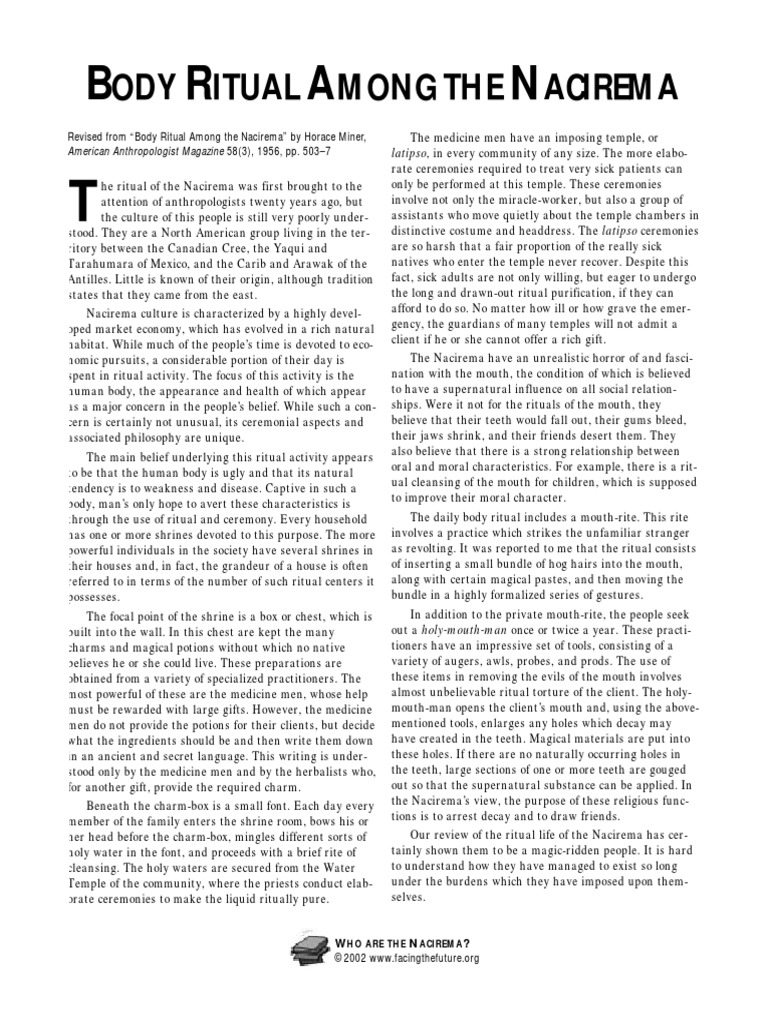The Nacirema, a term creatively derived from spelling “American” backward, serves as an anthropological lens through which to scrutinize the often bewildering and ritualistic behaviors of contemporary American society. While the term might initially conjure images of exoticism, it is paramount to recognize that the underlying observations pertain to our everyday lives. The rituals of the Nacirema invite a deeper contemplation of cultural practices, illustrating how mundane behaviors are cloaked in profound significance.
At first glance, the rituals of the Nacirema may seem curious or even bizarre. They possess an array of idiosyncratic habits and belief systems that often force the observer to reassess their own cultural practices. The daily ablutions performed by Nacirema individuals, ostensibly to maintain personal hygiene, hold deeper significance beyond mere cleanliness. These rituals reflect a pervasive anxiety regarding bodily appearance and societal acceptance, navigating the complex interplay between individual identity and collective expectation.
One prominent ritual involves a series of elaborate lineages dedicated to oral health, which includes the use of a small tool for scraping the teeth and a poultice made from various plant extracts. For an outsider, the fixation on teeth may appear trivial; however, this reflects a deep-seated societal priority placed on aesthetics and social standing. The Nacirema’s obsession with dental care offers an apt parallel to the relentless pursuit of perfection seen across various cultures, emphasizing how values around appearance can overshadow substantive concerns such as personal health and well-being.
Moreover, rituals surrounding the Nacirema’s body are steeped in tradition. The “Holy Mouth Men,” individuals who perform these oral customs, symbolize more than just health practitioners; they represent a societal power structure where expertise is mystified and revered. This phenomenon encapsulates broader societal dynamics in which certain professions are elevated to a status that can dictate personal choices and beliefs. Just as the Nacirema may worship the knowledge of their Holy Mouth Men, individuals globally can be swayed by the influence of authorities—whether they be medical professionals, scientists, or trendsetters—in shaping health perceptions and behaviors.
Nevertheless, the complexities of the Nacirema extend beyond personal vanity and health rituals. Cultural practices have often served as a focal point for evaluating broader socio-political matters. The Nacirema engage in regular visits to their “latipso,” a structure that ostensibly embodies the pinnacle of medical advancement. This facility, however, comes with its own suite of rituals, characterized by a series of rites that serve as prerequisites for receiving treatment. The interplay between access to healthcare and ritual participation mirrors real-world struggles regarding health equity, underscoring that systemic inequalities are frequently embedded within seemingly neutral practices.
The role of the “latipso” in the lives of the Nacirema captivates attention not merely because of its physicality but also due to its representational significance. Access to health services is often dictated by socioeconomic status, thereby reinforcing the disparities present in many societies worldwide. Consequently, the rituals surrounding the latipso become a microcosm for understanding the complexities of healthcare access and the societal constructs that govern it.
Additionally, the Nacirema exhibit a notable fascination with preserving youth, often culminating in a myriad of personal care rituals aimed at defying the passage of time. This obsession with youthfulness—perpetuated by an incessant bombardment of media messaging—illuminates an overarching societal narrative where the aging process is frequently stigmatized. Such a fixation not only commodifies aging but also fosters a culture of dissatisfaction among individuals, who feel pressured to conform to unattainable ideals.
Yet, amidst the whimsicality of rituals, the essence of Nacirema practices unveils deeper insights into their values and collective psyche. These customs encapsulate profound fears, aspirations, and the intrinsic need for communal identity. Rituals often serve to instill a sense of belonging—both within a community and in relation to the larger human experience. The socio-cultural tapestry woven by Nacirema practices tightly links the individual with the collective, stimulating reflections on one’s place in the world.
To shift the focus from the ceremonies directly, one must also consider the metaphorical implications of the Nacirema in understanding the intricacies of interaction with the environment. The echo of various rituals extends beyond interpersonal relations, posing critical inquiries into humanity’s relationship with nature. The Nacirema’s propensity for commodifying resources—whether through endless consumption or environmental exploitation—invites reflection on how societal constructs shape environmental degradation, prompting crucial questions regarding sustainability and responsibility.
Investigating the Nacirema through such a multifaceted lens exemplifies the importance of cultural introspection. It champions an understanding that, despite the apparent peculiarity of behaviors, many practices bear significant links to underlying human experiences. As such, the examination of the Nacirema transcends mere curiosity, urging a consideration of broader societal structures, environmental stewardship, and the values that ultimately shape our world.
In conclusion, the Nacirema, while ostensibly distant and esoteric, provides an illuminating mirror reflecting contemporary human dynamics. Their rituals encapsulate a profound amalgamation of identity, societal norms, and cultural expressions. This engagement urges a critical examination of not only those peculiar practices but also the foundational values governing behavior in any context. By embracing the Nacirema narrative, one encourages a broader discourse on humanity’s intrinsic connections—to each other, our bodies, and the world at large.
